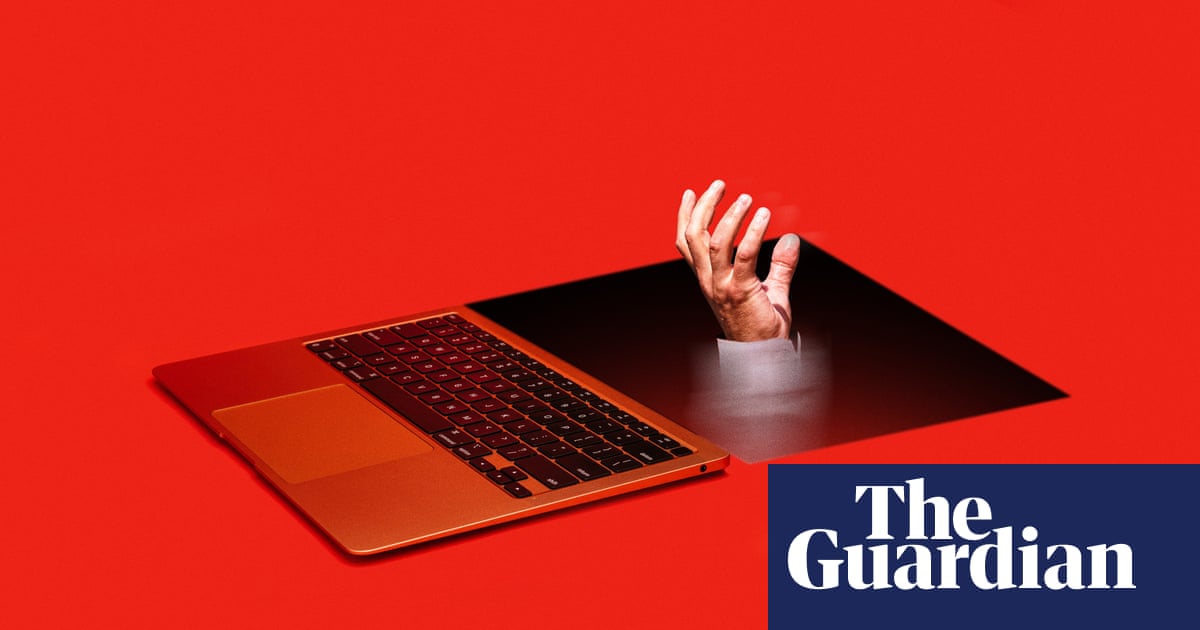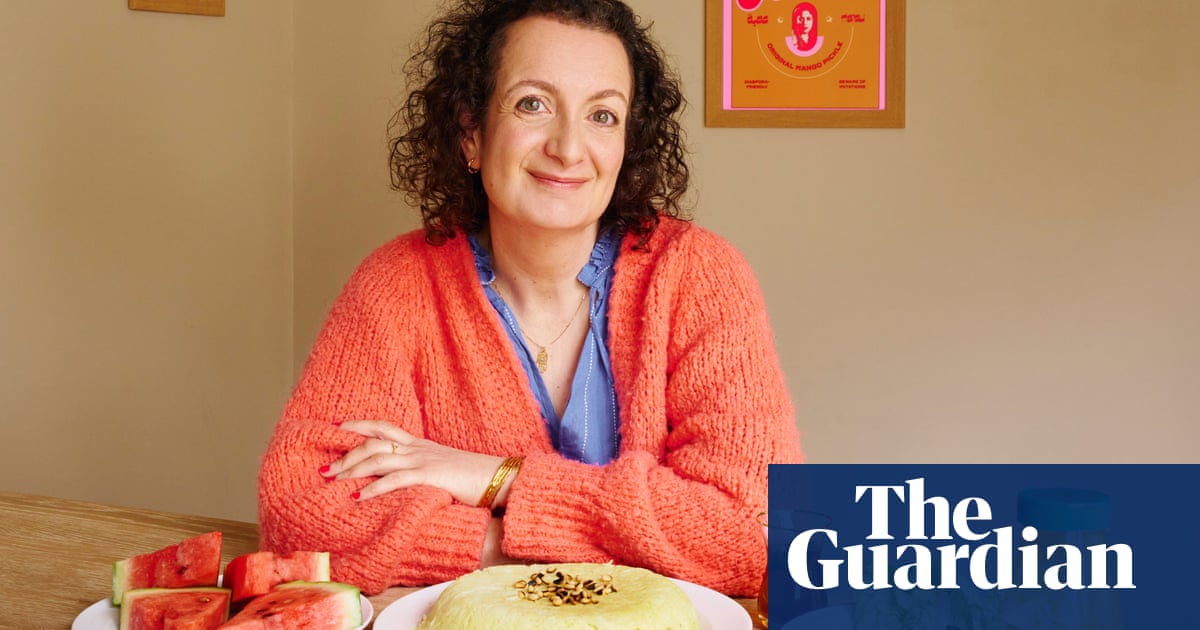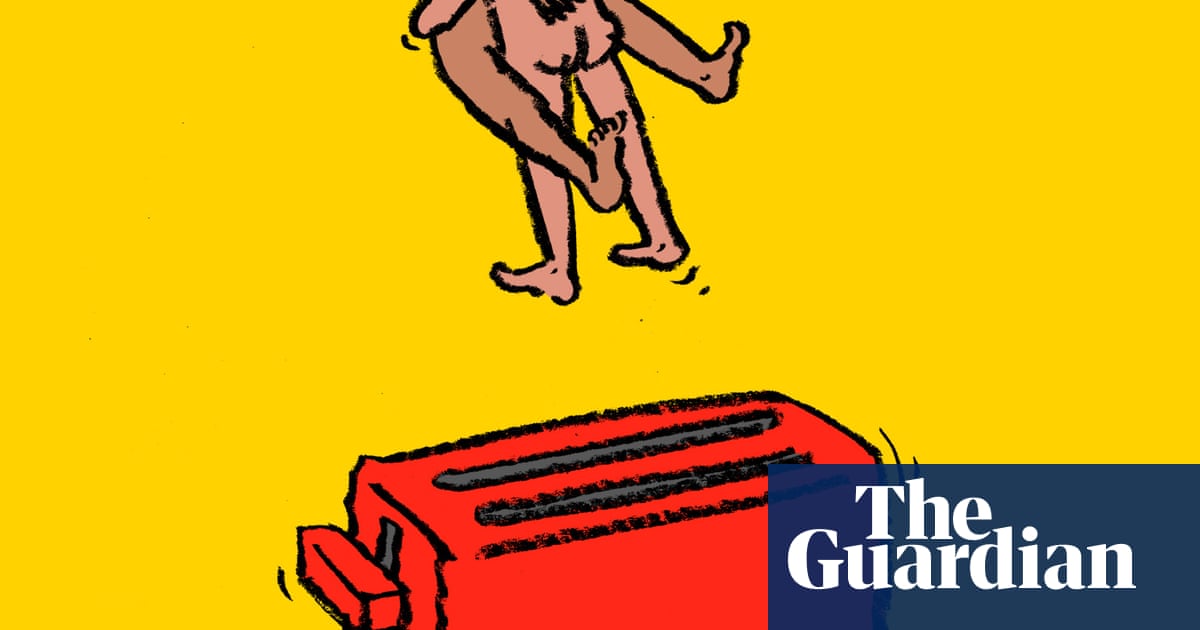Andy was enjoying a weekend away with his wife when it happened. “My neighbour phoned me and said, ‘The police are in your house. They’re looking for you.’” He didn’t need to wonder why. “You know. You know the reason. I was petrified when I got that call. It wasn’t just the thought of other people knowing what I had done; I also had to face myself, and that is a sick feeling – it is guilt, shame.”
Andy had been watching and sharing images of children being sexually abused for several months before the police appeared at his door. He tried at first to keep it from his wife: “I was afraid she would ask me to leave. I wouldn’t have blamed her if she had.”
When they got home, he told her his story: that a spiralling porn addiction had led him to ever darker places, chatrooms where people talked about sex and porn, and shared images and videos. “That was where someone sent me a picture of a child, in exchange for some porn I sent them.”
Unlike Andy, Mark didn’t immediately realise why the police had come for him. “My then wife came in looking worried and said, ‘There are police at the door.’ We were living in a wealthy area, so I thought they were there about some recent burglaries. But then they told me they needed to speak to me alone. They said I was being arrested for having indecent images of children.”
Mark claims he was shellshocked. “I knew I had looked at lots of porn but I genuinely did not think there was anybody underage in there. They said they had found 200 illegal images.” From the outside, Mark was a successful businessman, travelling regularly for work. His arrest was a public humiliation. “There were four of them, with body cameras on, in two cars. They told my boys, ‘Don’t worry, Daddy is just helping us out’ and put me in the back of one of the cars. In the picture the police took that day, I look suicidal.”
In England and Wales, 850 men a month are arrested for online child abuse offences. They come from every walk of life: teachers, police officers, bus drivers, doctors. Those on the frontline are warning of another alarming trend: a significant shift towards younger offenders among those picked up for watching illegal material.
The arrests are just one metric pointing towards a spiralling global crisis. Last year was the worst on record for instances of online child sexual abuse imagery, with the UK’s Internet Watch Foundation acting to remove content from 300,000 web pages, each containing at least one, if not hundreds or thousands, of illegal images and videos.
Now, police, charities, lawyers and child protection experts are asking what is driving this tidal wave of offending, and finding one common thread: the explosion over the past 10 to 20 years of free-to-view and easily accessible online pornography. Material so violent it would have been considered highly extreme a generation ago is now readily available on iPads, desktops and the phones in teenagers’ pockets. A growing body of research is beginning to warn of how problematic porn habits can be a pathway into viewing images of children being abused.
I have been writing about the online child abuse crisis for five years. Time and again I have heard warnings from those on the frontline that there is an unambiguous link between the two. Do the sites that profit from porn have questions to answer about this link? Can the connection be broken? And the big question: is the explosion of child abuse imagery online feeding a demand for this material, or creating one?
The scale of the problem faced by the police was made clear to the public last year, when former BBC presenter Huw Edwards was given a suspended sentence, avoiding jail time, after being found guilty of accessing indecent photographs of children as young as seven. This highlighted the fact that most people – around eight out of 10 – caught with images of children being sexually abused are not jailed. The National Crime Agency has called for more prison sentences, warning that up to 830,000 adults in the UK, 1.6% of the population, pose a threat to children.
Andy was sent to prison for six months for watching and sharing images of child abuse. I spoke to him through the Leeds-based charity Safer Lives, which works with men at every stage, from arrest to post-conviction counselling, to help them change their behaviour. Like many of the men they encounter, Andy argues that he has no intrinsic interest in children, but was led through a porn addiction to seek out ever more extreme images. “I am fully accountable,” Andy tells me on the phone. “None of this is an excuse. I look back at what I did with huge regret and shame. But I didn’t start out wanting to see kids. I was addicted to porn and I went down a road of being totally desensitised as I got further and further from what was normal.
“I was using porn as a coping mechanism for all sorts of things – stress, loss, general life problems. When you masturbate to porn, you get an intense dopamine hit. Then those first videos start to become boring. Your brain starts to say, that’s not good enough. Soon you are watching rape fantasies – there are loads of categories like this on mainstream sites. Then it’s teenagers. The algorithms keep showing you more extreme stuff.”
He argues that the mainstream porn sites encourage an interest in young girls. “They push the boundaries as much as they can, with content around young women dressed in school uniforms, for example; incest themes; old men paired with young women.”
I ask where his own moral judgment was when watching videos of teenagers. “Yes, I could have wondered if those girls were really over 18. But you think, well, I’m on a site anyone can access, it’s legal. You can watch this on the bus, right? You are in an environment that is eroding your sense of responsibility.”
As many offenders do, he moved to chatrooms where men shared images and videos from porn sites they liked. It was in this space, he says, that he was first sent a picture that was clearly of a child. “You know it’s wrong, but the dopamine hit from what you are doing overrides everything else. I think the pathways in my brain had been changed by all the porn I had watched.”
Afterwards, he admits, “You feel sick and horrible. For years I didn’t talk about this. But now I want to stop other men continuing down the path I went down.”
Mark has a similar story. He is open in saying his interest began with legal material of teen girls but says he was taken to images of children through hours of clicking on everything offered to him. “I have gone through about 40 sessions of counselling to try to understand why I ended up in a place where someone could knock on my door to arrest me. I was horrified and disgusted with myself, and I will be until the day I die.”
Porn was a coping mechanism when he was away from his family, he says, and it quickly got out of control. “I worked abroad a lot and was bored and lonely. I was bringing up porn on my phone the moment I was travelling, watching it sometimes for five hours a day.
“The police never found a single search for images of children: it was all from clicking through links – what the algorithms were offering me. Porn sites have a button that says ‘See more like this’. I was desensitised, I had looked at so much teen porn.”
Mark was convicted of possessing images in categories A, B and C. The worst of these, A, involves the penetration of children under 18. “I understand now that my reaction should have been to turn off the computer when I was being offered images of young girls. But when you have been watching porn for three or four hours, you might have clicked 200 times. You are in such a bizarre place, your hormones are all over the place. You – your brain – are out of control.”
As part of his counselling, Mark has written a letter to one of the young girls he watched, “not to send, but for therapy. She could, I suppose, have been 16 or 17. It was a long letter. I explained how I got to be there, I was hugely apologetic.”
The idea that there is a path that for some people leads from legal porn to videos of children being abused is controversial. Many of the men being arrested for online child abuse offences pose a serious risk to children. But there is no doubt that the profile of offenders has changed in recent years. Michael Sheath worked with child abusers for more than 30 years and now advises police forces around Europe on offender profiling. When I speak to him, he has just returned from an Interpol conference on online child abuse. “I’ve been every year for 14 years and we have seen a shift over that time, from what we would call serious criminal paedophiles, the type who are organising the abuse of kids in the Philippines, and we still see those, to a huge number of lower-level offenders. It’s a huge burden on the police.”
He is in no doubt that the change is linked to increasingly easy access to violent and extreme pornography. “I see men who have gone down what I call an ‘escalating pathway’. The link is unambiguous.”
Sheath speaks powerfully about what he sees as a horrific impact of porn on societal taboos that have traditionally protected children. “The threshold for abusive behaviour is through the floor. It used to be that child abuse material was hard to find and looking at it was extremely risky. The mindset of someone searching for it would be ‘I am a total sex criminal’ – they knew they were leaving the norms of society.
Now it is barely taboo to watch children being abused, and that is linked to porn. Look on a mainstream porn site and you’ll immediately see titles like ‘Auntie takes the boys’ virginity’ or ‘Stepdad and stepdaughter’. When I started working 30 years ago, that was really out-there outrageous, pervy and wrong. Now it’s seen as a laugh.”
The videos he is referring to are legal content acted by adults, not hidden but watched by millions in the UK. “There is a slope and it is slippery, but that doesn’t mean men shouldn’t be held to account for being complicit in the abuse of the child.”
Serious research is now being done into how this slippery slope works. In a groundbreaking two-year project, Finnish group Protect Children posted questionnaires on the dark web to reach people viewing illegal material in several countries, including the UK. They collected data from 4,549 anonymous child sexual abuse offenders. A third of respondents admitted that sexual interest in children was a key reason why they searched for child sexual abuse material. Nearly two-thirds reported a sexual interest in under-18s – mostly teens between 15 and 17. Heavy use of pornography is described as one of the “facilitating factors” that can play an important role in lowering the barrier to offending.
More than 50% of those who admitted watching online child abuse said they were not seeking these images when they were first exposed to them. This did not mean they did not go on to search for violent and harmful images of children. The prevalence of this “accidental viewing” is underlined by the huge number of respondents – over two-thirds – who said they first saw child sexual abuse material when they were under 18. Of those, 40% were under 13.
Along with other countries, the UK is bringing in tighter controls on the porn industry. Porn sites will be required to have age verification processes in place by July to stop children viewing their content, a process that will be monitored by Ofcom under the new Online Safety Act (OSA). But the OSA does not ban or control certain common practices in porn, such as strangulation, sexual fetishisation of incest or the abuse of children acted by adults. The government argues depiction of sexual strangulation is banned but a recent in-depth review of porn by Baroness Bertin, a Conservative peer, warned it is not, in reality, covered by case law. She called for tighter regulation of “legal but harmful pornography like choking, violent and degrading acts … even content that could encourage child sexual abuse”. While headlines picked out the call to ban strangulation, Bertin also demanded clearer rules around “incest, step-incest and ‘teen’ porn”.
after newsletter promotion
For years, evidence has been building that extreme material is too easily available to first-time viewers, served to them by the powerful algorithms that drive porn sites. In 2021, research professor Dr Fiona Vera-Gray and others at Durham University found that one in every eight titles on the front pages of the most popular porn sites showed sexual violence against women and girls. They also found that videos tagged as “teen” were more likely to be linked to violence.
In January, Pornhub’s owners, private equity firm Ethical Capital Partners (ECP), arrived in London from the US and Canada to lobby against the UK’s implementation of age verification. Sarah Bain, vice-president of public engagement for ECP, and Alexzandra Kekesi of Pornhub pushed for “device-based” age blocks instead of “site-based” checks – ie the phone would block underage users, not the website.
Bain and Kekesi insist that Pornhub is an industry leader in ensuring content does not “cross the line” into abusive themes. They say they carefully monitor content to ensure all performers are over 18. “We have very strict protocols for the type of content that could potentially be harmful,” Bain says. She refers to the “constantly evolving” list Pornhub says it has of 34,000 banned words. “This would prevent anyone uploading content with these words, or commenting under a video with these words. We have banned terms that are legal. We make a decision not to monetise content on those themes. This is not always popular with content creators, but we are willing to be out there, modelling to other folks in the porn industry that you can be an ethical business.” They also argued that some fantasy themes can be “empowering” for those engaged in safe and consensual BDSM.
In 2021, the anti-trafficking organisation Cease published a report that listed some of Pornhub’s banned terms next to words that are still allowed, to highlight what it says is a continuing presence of highly violent content themed around the abuse of children and teenagers. The word “rape” is banned, but permitted terms include “dazed”, “broken”, “degraded”, and interactions based on power abuses are common (“stepdad and stepdaughter”, where the stepdaughter might be “scared or trapped”). The word “incest” is blocked, yet permitted terms include “daddy and daughter, grandpa and granddaughter”. Words relating to “teen” (over 18) and “smallness” are common.
Pornhub’s own guidelines state: “We … prohibit content, including fictional, simulated, or animated, that features or depicts … nonconsensual sexual activity, including coerced or forced sexual acts, rape, or sexual assault.”
Pornhub says there are subtleties to certain words that they address through moderation. A spokesman said: “Some of the examples you listed that are not banned require context to understand. ‘Broken’, for example, has many different uses that would be perfectly within our terms of service. That’s why it’s so important that all content uploaded also undergoes our industry-leading trust and safety process as well.
“Even terms that are not banned on our platforms may be flagged by our internal system. Words like ‘daughter’ or ‘degraded’ or ‘scared’ are all flagged specifically to moderators and given higher scrutiny for contextual assessment.
Just because a video uses the word ‘father’, or ‘dad’, or ‘daddy’, or any other word like that, does not mean the person featured is a relative of their co-performer. [There] are a number of scenarios where a person may be called ‘daddy’, or another title like that, that are certainly not incestuous.
“Just because a word could, in certain contexts, be used in an abusive way, that does not mean that by ‘not banning it’, we are allowing content that violates our guidelines.”
The company has also partnered with the UK’s Internet Watch Foundation and anti-child abuse charity Lucy Faithfull Foundation to add warnings that pop up when users appear to be searching for child abuse content.
Underlying all this is the question of whether porn can be seen as addictive in the way Mark and Andy describe. Unlike other behavioural addictions, such as gambling and gaming, pornography addiction is not included in the International Classification of Diseases, compiled by the World Health Organization. It is instead defined as a compulsive sexual behaviour.
For at least a decade, mental health experts have warned that the release of the pleasure chemical dopamine during porn viewing means it impacts the brain in the same way as addictive substances such as drugs. In 2013, the psychiatrist Norman Doidge warned, “The brain is ‘neuroplastic’ and not only can it change, but it works by changing in response to repeated mental experiences.” He describes how dopamine is released as we accomplish goals, so we gain the thrill that encourages us to do it again. “Dopamine is secreted at moments of sexual excitement and novelty. Porn scenes, filled with novel sexual ‘partners’, fire the reward centre. The images get reinforced, altering the users’ sexual tastes.”
Last month, the Lucy Faithfull Foundation found that a fifth of adults reported their pornography viewing becoming gradually more extreme. Pornhub denies this is its intention and says users may “discover” new interests on porn sites but that they are not being deliberately pushed to extreme material.
A Pornhub spokesman told the Guardian: “Our understanding … is that many of the studies that suggest that porn is harmful to society are methodologically flawed and/or ideologically biased. Most research finds more neutral or ambiguous results, and the Diagnostic and Statistical Manual of Mental Disorders does not recognise porn addiction as a valid diagnosis.”
What is clear is that problematic use is rising – including among young people. At the Lucy Faithfull Foundation, their clients are getting younger, so much so that in 2023 they launched a specialist service for teenagers. DCI Tony Garner leads a team of online child abuse officers in Worcester. They carry out “the knock” three or four times a week and are increasingly finding teenagers behind the door. “We are seeing people who are turning 18 and have had 10 years’ exposure to hardcore porn. My officers are finding young people watching the most abhorrent material, including child abuse.” He is clear that the police cannot deal with this on their own. “As a country, as a society, it feels completely out of control.”
Marcus Johnstone of PCD solicitors specialises in defending sex offenders. He says he represents “people of every age, from every background. Most of them have children, many are very intelligent. They are looking at or requesting and selling images and videos. Or they are chatting to children on gaming sites and apps. I often wonder if parents know how many of the people their kids are gaming with online are people like my clients.”
But, like Garner, he is seeing an increasing trend towards younger offenders – often in their mid- or even early teens. “A lot of my clients now are parents who have called me because their child has been arrested. This is generation porn. They may have been looking for videos of teens their own age. Or they may have been talking to predatory adults online who shared material with them.”
Johnstone mentions the case of a young teen who wanted to see videos of teens his own age, “but these are category A images, which is a serious crime with a maximum sentence of 10 years in prison. The law is turning these young people into criminals at an alarming rate. I have seen young people banned from being in the same house as their younger siblings.”
Sheath says his decades working with offenders has made him incredibly concerned about the way children are growing up with access to porn. “This is an experiment we are doing as a society and I think we can agree it’s going pretty badly. Before the smartphone, most people’s first experience of sex was with a living person and that included resistance, pushback, romance. Now young people are growing up with unfettered access to porn, and porn norms are not about consent. They are about ‘strangle the bitch’, ‘have sex with your stepmum’. It’s shaping their erotic templates.”
Pornhub and ECP argue forcefully that they do not want children on their sites. “It’s shocking that we have to say this,” Bain says. “We want age verification. But the way we are seeing it approached – it’s not effective. They are targeting individual platforms. Louisiana, the first US state to implement this form of age verification, lost 80% of visitors to the site when they met the age check. Now, these people are not giving up on porn. They will go to other sites with no barrier.”
In most US states, Pornhub has opted to shut down its site rather than comply with age checks. It won’t be drawn on whether it will do the same in the UK – its fifth largest global market – if asked to age-block its sites from July. Kekesi says only, “We will obey the law.”
In the coming weeks, yet more men will wake up to a knock on the door and find the police outside. More images of children being abused will be taken and sent spiralling around the internet. Mark hopes some men might take a step back before it happens to them. At one point, he was prevented from being alone with his children but now he has unsupervised access again. His marriage ended and he began dating. He faced the difficult decision of how to tell his new girlfriend about his offences. “She was very kind, she let me talk. The natural reaction would be: urgh, you’re a paedophile. It’s worse than murdering someone. But I’m not a paedophile, I was just an idiot.”
He believes men have an urgent role to play in supporting the men around them. “There are pressures on men in modern life, and porn is one of the outlets people seek. But it can lead you down a dark path. I’m more observant now of other men’s mental health. I work in a tough industry but I ask men I know, ‘Are you OK?’”
Andy says he has learned he has an addictive personality. “You own your actions as an offender. You have to. But porn was what I went to when I had broken relationships, stress at work; porn made me feel better. And the hit is stronger if you know what you are doing is not legal or not right.”
Like many offenders, he says he is glad he was caught. “Without the arrest, I don’t think I could have just stopped. Think about alcohol, gambling – you don’t just suddenly stop. You have to go to AA, you have to do the work. I’ve had help now and I realise how awful it is. These are real children.” He adds, “I’ve done courses with Safer Lives, with the Lucy Faithfull Foundation. I’ve got apps on my phone including one that links everything I do online to my wife as my accountability partner. I see a therapist once a month.”
Jenny Greensmith is one of the lead counsellors at Safer Lives working with men like Andy and Mark. She has a background as a probation officer specialising in sexual offending and has sat through countless hours of conversations with offenders. “What I’m concerned about is oversimplifying this problem,” she says. “We don’t want to remove personal responsibility or suggest porn is always a gateway to harmful behaviour. But we want men to seek help; it won’t help if we regard them as perverts. I meet a lot of men who are not able to recognise their feelings, let alone manage them. The internet is an easy way to switch off from emotions.”
She is acutely aware of the real children hidden behind the words “category A, B and C”, particularly the teens whose videos the men say are easily confused with legal porn. “The CPS will often mention if pre-teen or young children are in the category A images because it’s an aggravating factor for sentencing. But it sometimes feels like an arbitrary line that diminishes the harm caused to people over 13 of having their most vulnerable experiences shared to millions online.”
Whatever offences the men have carried out, she stresses that dismissing them as beyond help can have serious consequences. “I understand some people will feel that is all they deserve, but I disagree. I am also acutely aware they often have children and families who will be destroyed by this.”
She would really like to reach people before they hear the knock at the door. “Men often tell us, ‘I wish I had known you were here earlier, I wanted to stop.’”










